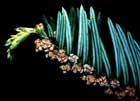
New and mature foliage, and active staminate strobili on an ornamental specimen [C.J. Earle, 1999.05].
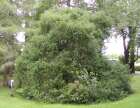
Large ornamental tree in Yatton Park, New Zealand [C.J. Earle, 2003.03.02].
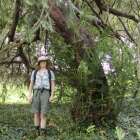
Base and trunk of the above tree [C.J. Earle, 2003.03.02].
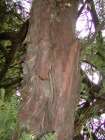
Trunk and bark of the above tree [C.J. Earle, 2003.03.02].
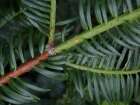
Foliage and branchlets of the above tree [C.J. Earle, 2003.03.02].

Cephalotaxus harringtonia
(Knight ex J. Forbes) K. Koch 1873
Common names
Inugaya, Japanese plum yew (Tripp 1995), cow's-tail pine (Vidakovic 1991). Var. nana: Hai-inugaya (Sylvain Meier email 2007.01.29).
Taxonomic notes
Syn: Taxus harringtonii Knight ex J. Forbes 1839; C. drupacea Sieb. et Zucc. 1846; C. pedunculata Siebold et Zucc. 1846; C. drupacea var. pedunculata (Sieb. et Zucc.) Miq. 1867; C. drupacea var. harringtonii (Knight ex J. Forbes) Pilger 1903; C. harringtonii var. drupacea (Sieb. et Zucc.) Koidz. 1930. Two varieties, the type and nana (Nakai) Rehder 1941 (Farjon 1998). Some authors place C. koreana and C. sinensis in synonymy, and because of this, as well as its long horticultural history, it is the species of Cephalotaxus most often encountered in the literature and, in the West, in cultivation. The molecular analysis of Hao et al. (2008) showed that the clade C. harringtonia - C. koreana - C. wilsoniana is monophyletic, and that the latter two species could be treated as varieties of C. harringtonia.
Description
The following description was applied to var. drupacea, which, as noted above, is here placed in synonymy with the type variety: "A short, up to 10 m high tree or a bush with spreading branches. Crown broadly rounded. Bark gray, peeling longitudinally in thin strips. Shoots green when young, later red-brown. Needles in 2 ranks, dense, spreading outwards and upwards, 2.5-3.5 cm long, 2-3 mm wide, distinctly acuminate, glossy, with 2 light stomata bands below. 'Fruit' ovate, about 3 cm long, on a 6-12 mm long stalk. Flowers appear in March and April, and fruit ripens in September; out of 12 chromosomes, one has a subterminal centromere, and the others median or submedian centromeres; subterminal chromosome has a satellite on its short arm (Mehra and Khoshoo, 1956)" (Vidakovic 1991). Var. nana has shorter and more slender needles than the type, the fruits are smaller, and the plants are shorter with a more upright, suckering habit; it spreads by layering (Tripp 1995).
Distribution and Ecology
Japan: Kyushu to Hokkaido, specifically Hondo, pref. Chiba, Mt Kiyosumi, Amatsu-machi, Awa-gun, prov. Awa; Nagasaki; Hiroshima pref. Var. nana found in E Honshu & Hokkaido, typically on seaside cliffs and in mountainous areas (Tripp 1995). Thrives in partial shade on deep, rich soils (Vidakovic 1991). Hardy to Zone 7 (cold hardiness limit between -17.7°C and -12.2°C) (Bannister and Neuner 2001).
As var. drupacea, it is listed as threatened in Vietnam by the WCMC (2001).
Remarkable Specimens
In 1916, the great plant-hunter E. H. Wilson reported "The largest I saw grow in the rich forests at the foot of Higashi-Kirishima [in Kyushu] ... I saw many trees from 8 to 10 m tall with ... wide-spreading branches forming broad rounded crowns" (Wilson 1916).
Ethnobotany
The most popular Cephalotaxus in ornamental use, with several described cultivars that vary in growth habit, shade tolerance, and cold tolerance (USDA Zones 5 to 9) (Tripp 1995).
Observations
No data as of 2023.02.23.
Remarks
Named for the Earl of Harrington, one the the species' first European fanciers.
This was the first species of Cephalotaxus found and described by western plant hunters, and is still the one most commonly seen in cultivation (Tripp 1995).
Citations
[WCMC] World Conservation Monitoring Centre. The Socialist Republic of Viet Nam
Appendix 5 - Threatened Plant Species. http://www.wcmc.org.uk/infoserv/countryp/vietnam/app5.html, accessed 2001.11.25, now defunct.
Wilson, E.H. 1916. The conifers and taxads of Japan. Publ. Arnold Arbor. 8, Univ. Press, Cambridge, Mass. Available: Biodiversity Heritage Library, accessed 2021.12.19.
See also
Elwes and Henry 1906-1913 at the Biodiversity Heritage Library (as C. drupacea and C. pedunculata). This series of volumes, privately printed, provides some of the most engaging descriptions of conifers ever published. Although they only treat species cultivated in the U.K. and Ireland, and the taxonomy is a bit dated, still these accounts are thorough, treating such topics as species description, range, varieties, exceptionally old or tall specimens, remarkable trees, and cultivation. Despite being over a century old, they are generally accurate, and are illustrated with some remarkable photographs and lithographs.





